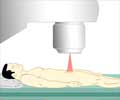
‘Given the high SUV in tumor and localization of a large number of lesions, this reagent warrants further exploration as a companion diagnostic in patients undergoing STEAP1-directed therapy.’
Read More..Tweet it Now
"While significant strides have been made in detection of mCRPC with radiolabeled antibodies and small molecules that recognize prostate-specific membrane antigen (PSMA), other important potential targets, such as STEAP1, could be imaged to identify presence of mCRPC and possibly serve as therapeutic targets," said Jorge A. Carrasquillo, MD, who performed the study while an attending physician at Memorial Sloan Kettering Cancer Center in New York, New York. "89Zr-DFO-MSTP2109 represents a novel theranostic reagent to both identify the extent of metastatic prostate cancer and select patients for STEAP1-directed therapies."Read More..
The prospective single-phase study included 19 patients with histologically confirmed progressing mCRPC with documented metastatic disease on bone scans, computed tomography (CT) or magnetic resonance imaging. Patients received approximately 185 MBq/10mg of 89Zr-DFO-MSTP2109A and were imaged four to seven days after the injection. Uptake and localization in tumor were measured and compared with bone and CT scans. Bone and soft tissue biopsy samples also were evaluated.
All patients imaged with 89Zr-DFO-MSTP2109A were considered positive for bone lesions, and eight patients were considered to have soft-tissue disease. Localization of 89Zr-DFO-MSTP2109A in suspected bone metastases was observed in all patients; a total of 515 sites were recorded as positive. Analysis of bone lesions showed a median maximum SUV of 20.6, while an analysis of soft tissue lesions showed a median maximum SUV of 16.8.
Researchers also analyzed biopsies performed under other research protocols or for clinical indications either before or after imaging with 89Zr-DFO-MSTP2109A. High uptake values of 89Zr-DFO-MSTP2109A were noted in 11 of 12 bone sites biopsied and all five soft-tissue sites, each of which was confirmed as histologically positive. As researchers were unable to biopsy all cancerous lesions, a Bayesian approach was used to apply information gleaned from biopsied lesions to project the number of cancerous lesions in each patient. Use of this approach resulted in a best estimate of 86 percent of histologically positive lesions being true-positive on imaging with 89Zr-DFO-MSTP2109A. "To our knowledge, this is the first study to report in detail on the imaging findings of targeting STEAP1," said Carrasquillo. "Given the high SUV in tumor and localization of a large number of lesions, this reagent warrants further exploration as a companion diagnostic in patients undergoing STEAP1-directed therapy." He continued, "The difference we observed in targeting PSMA with various radiotracers in patients with prostate cancer may possibly reflect differences related to the biology of STEAP1-versus PSMA-positive prostate cancer. Furthermore, as radiolabeled anti-PSMA antibodies were superseded by small molecules for PSMA imaging, there is potential to develop small molecules to target STEAP1 as well."
Source-Eurekalert







![Prostate Specific Antigen [PSA] Prostate Specific Antigen [PSA]](https://www.medindia.net/images/common/patientinfo/120_100/prostate-specific-antigen.jpg)





